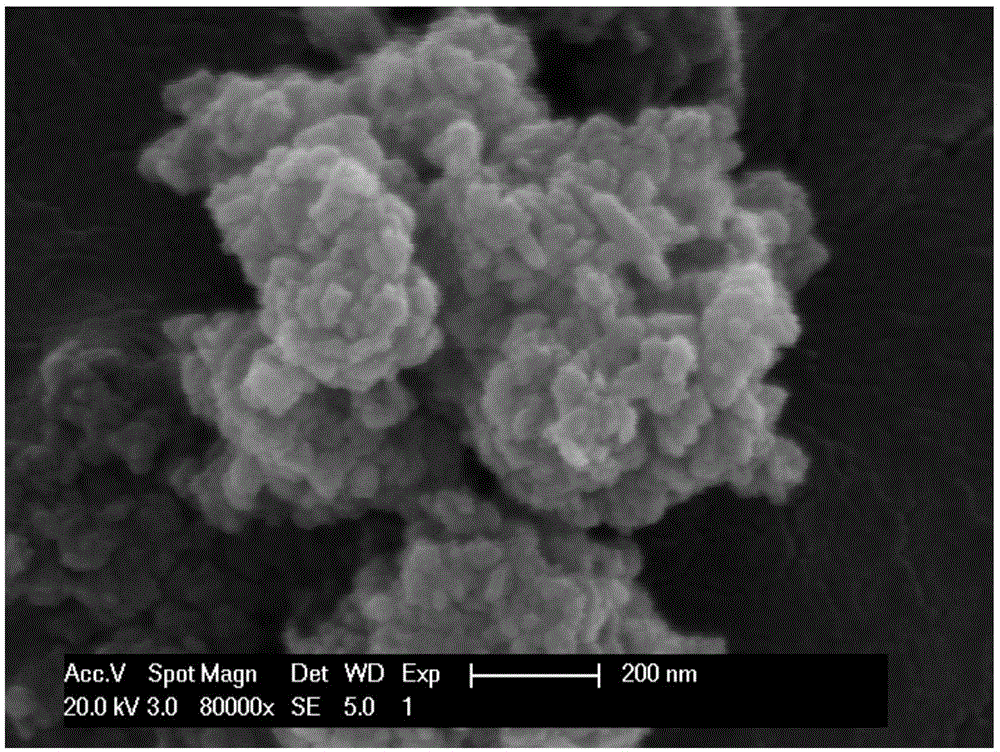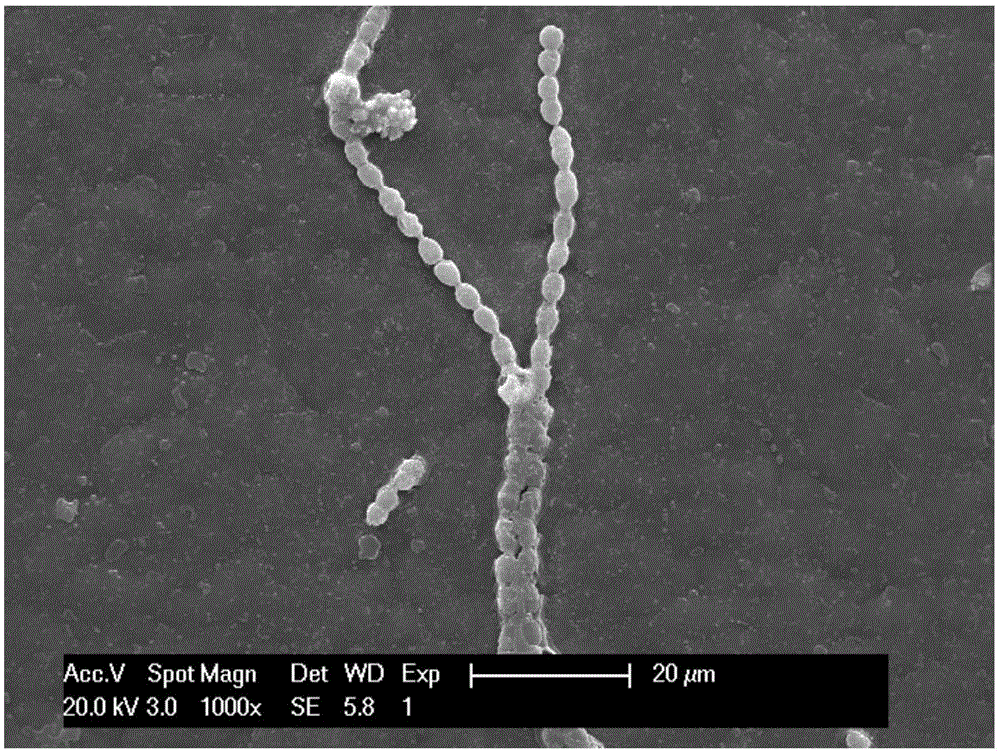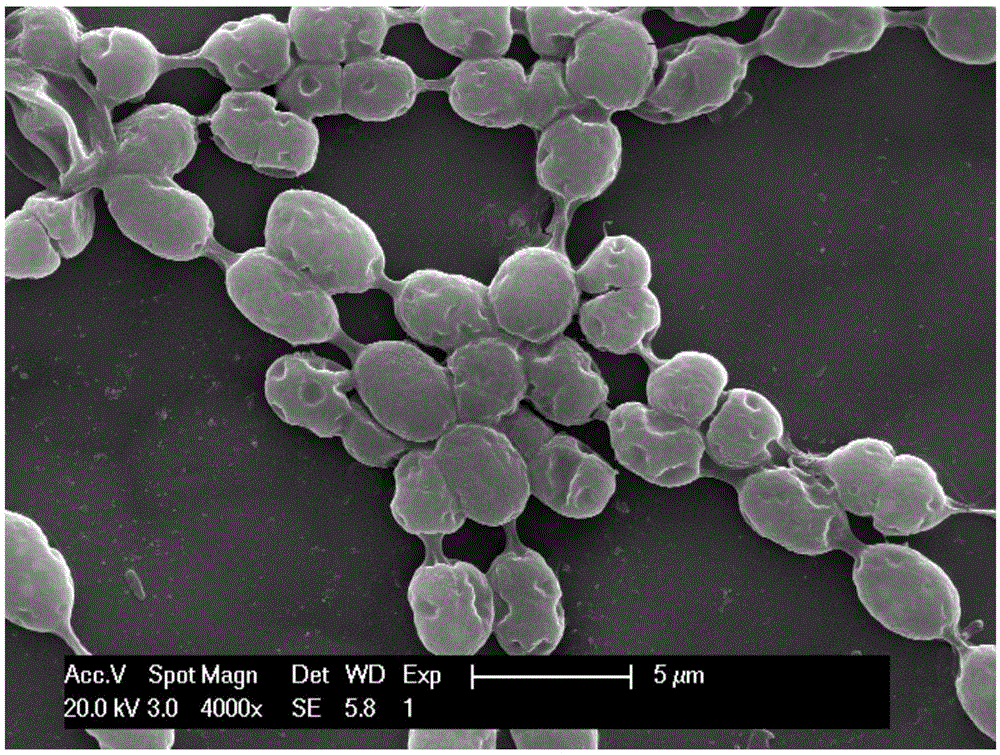A kind of compound algae removal method
An algaecide and cyanobacteria technology, applied in the field of water treatment, can solve the problems of rising copper salt concentration and harming human health, etc., and achieve the effect of strong adsorption capacity and improving algae removal efficiency.
- Summary
- Abstract
- Description
- Claims
- Application Information
AI Technical Summary
Problems solved by technology
Method used
Image
Examples
Embodiment 1
[0022] A compound algae removal method, the method comprises the following steps:
[0023] (1), 1000mg / L of TiO 2 Nanomaterials (50-200nm) were sonicated in 100mL of distilled water for 1h as nanomaterial storage solution. TiO 2 Schematic diagram of scanning electron microscopy of nanomaterials in water figure 1 shown.
[0024] (2), make copper sulfate algaecide into a solution, and then add TiO 2 Nanomaterials, controlling TiO 2 concentration.
[0025] (3), prepare 6 parts of the same Anabaena, each 100mL, OD680 between 0.1 ~ 0.2, add the mixed solution prepared in step (2), and meet the requirements of Cu in the solution by adding different amounts of copper sulfate algicides. 2+ When the concentration is 0.01, 0.02, 0.04, 0.05, 0.06, 0.07, 0.08mg / L, TiO 2 Concentrations were controlled at 0, 1.0, 10.0mg / L respectively:
[0026] (4) After stirring, the flocs in the solution can be separated.
[0027] Due to TiO 2 Incorporation of nanomaterials, TiO 2 Can be adsorb...
Embodiment 2
[0030] A compound algae removal method, the method comprises the following steps:
[0031] (1), 1000mg / L of TiO 2 Nanomaterials (50-200nm) were sonicated in 100mL of distilled water for 1h as nanomaterial storage solution.
[0032] (2), make copper sulfate algaecide into a solution, and then add TiO 2 Nanomaterials, controlling TiO 2 concentration.
[0033] (3), prepare 6 parts of the same Microcystis aeruginosa, each part of 100mL, OD680 between 0.1~0.2, add the prepared mixed solution of step (2), make each part of Cu 2+ The concentration is 0.08mg / L, while TiO 2 Concentrations are 0, 0.5, 1.0, 2.0, 5.0, 10.0mg / L;
[0034] (4) After stirring, the flocs in the solution can be separated.
[0035] It was found that 1.0mg / L of TiO 2 When present, CuSO 4 The algicidal effect is the best, Cu 2+ EC 50 =0.033mg / L, but without Ti0 2 And add 10.0mg / L of TiO 2 EC 50 0.053mg / L and 0.048mg / L respectively, Cu 2+ Cytotoxicity in small amounts of TiO 2 Significantly enhanced ...
Embodiment 3
[0037] A compound algae removal method, the method comprises the following steps:
[0038] (1), 1000mg / L of TiO 2 Nanomaterials (50-200nm) were sonicated in 100mL of distilled water for 1h as nanomaterial storage solution.
[0039](2), make copper sulfate algaecide into a solution, and then add TiO 2 Nanomaterials, controlling TiO 2 concentration.
[0040] (3), prepare 6 parts of the same chlorella, each 100mL, OD680 between 0.1~0.2, add the mixed solution prepared in step (2), make each part of Cu 2+ The concentration is 0.08mg / L, while TiO 2 Concentrations are 0, 0.5, 1.0, 2.0, 5.0, 10.0mg / L:
[0041] (4) After stirring, the flocs in the solution can be separated.
[0042] It was found that 1.0mg / L of TiO 2 When present, CuSO 4 The algicidal effect is the best, Cu 2+ EC 50 =0.033mg / L, but without TiO 2 And add 10.0mg / L of TiO 2 EC 50 0.053mg / L and 0.048mg / L respectively, Cu 2+ The cytotoxicity of TiO2 was significantly enhanced in the presence of a small amount...
PUM
| Property | Measurement | Unit |
|---|---|---|
| particle diameter | aaaaa | aaaaa |
Abstract
Description
Claims
Application Information
 Login to View More
Login to View More - R&D
- Intellectual Property
- Life Sciences
- Materials
- Tech Scout
- Unparalleled Data Quality
- Higher Quality Content
- 60% Fewer Hallucinations
Browse by: Latest US Patents, China's latest patents, Technical Efficacy Thesaurus, Application Domain, Technology Topic, Popular Technical Reports.
© 2025 PatSnap. All rights reserved.Legal|Privacy policy|Modern Slavery Act Transparency Statement|Sitemap|About US| Contact US: help@patsnap.com



